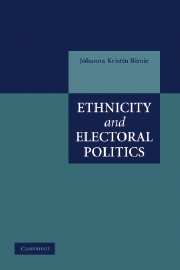Book contents
- Frontmatter
- Contents
- List of Tables and Figures
- Acknowledgments
- 1 Introduction: The Ethnic Effect
- 2 Ethnic Attractors
- 3 Ethnic Attractors and Exogenous Constraints
- 4 Ethnic Voting in Romania
- 5 Ethnic Voting and Party System Stability
- 6 Ethnic Politics and Access
- 7 The Ethnic Effect on Regime Stability
- 8 Conclusions
- Appendix A The Model (Formal Version)
- Appendix B Measurements and Other Methods Issues
- References
- Index
1 - Introduction: The Ethnic Effect
Published online by Cambridge University Press: 03 December 2009
- Frontmatter
- Contents
- List of Tables and Figures
- Acknowledgments
- 1 Introduction: The Ethnic Effect
- 2 Ethnic Attractors
- 3 Ethnic Attractors and Exogenous Constraints
- 4 Ethnic Voting in Romania
- 5 Ethnic Voting and Party System Stability
- 6 Ethnic Politics and Access
- 7 The Ethnic Effect on Regime Stability
- 8 Conclusions
- Appendix A The Model (Formal Version)
- Appendix B Measurements and Other Methods Issues
- References
- Index
Summary
Strange Attractors
And ourselves, fluttering toward and away in a pattern that,
given enough
Dimensions and point-of-view,
Anyone living there could plainly see –
Dance and story, advance, retreat,
A human chaos that some slight
Early difference altered irretrievably?
Chapman and Sprott, Images of a Complex World: The Art and Poetry of ChaosAfter completing field research in Ecuador in 1998 I traveled around the country sightseeing. Returning one afternoon from a visit to the beautiful Presidential Palace in the old part of Quito, I narrowly escaped indigenous demonstrations turned violent. The protests in the summer of 1998 marked the culmination of events that began in the late 1980s and early 1990s, when indigenous communities throughout Ecuador were organizing strikes, roadblocks, land seizures, occupation of buildings, and other demonstrations. Autochthonous protests led to the ousting of two Ecuadorian presidents, Jamil Mahuad in January 2000 and Lucio Gutiérrez in 2005. The relationship between the state and indigenous groups remains strained, although some improvements are notable (Birnir, 2004-a).
Two years later in Bolivia I observed a similar, if more strained, relationship between indigenous leaders and the political elite of the country. My interviewees were uniformly concerned, with good reason, about deteriorating ethnic relations in the country. Recent reports of ethnic violence in Bolivia include the lynching of a mayor associated with a nonethnic party in the town of Ayo Ayo by several members of indigenous groups.
- Type
- Chapter
- Information
- Ethnicity and Electoral Politics , pp. 1 - 18Publisher: Cambridge University PressPrint publication year: 2006



